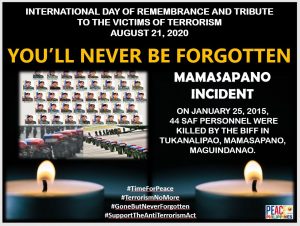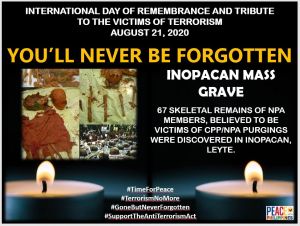THE National Task Force to End Local Communist Armed Conflict (NTF-ELCAC) has listed at least 14 “acts of terrorism” incidents perpetrated by local terrorist groups that claimed hundreds of lives ahead of the commemoration of the ‘International Day of Remembrance and Tribute to the Victims of Terrorism’ this coming August 21, 2020.
Also known as ‘TF70’ based on Executive Order 70 signed by Pres. Duterte last December 10, 2018, it is primarily focused on the implementation of a ‘Whole of Nation’ approach in dealing with the continuing national security threat posed by the Communist Party of the Philippines and its armed wing, the New People’s Army (CPP-NPA).
TF70, however, is also conscious on the national security threat posed by Muslim extremists like the Abu Sayyaf Group (ASG) and other Islamic State (IS) terror groups such as the Bangsamoro Islamic Freedom Fighters (BIFF), mainly based in Mindanao island.
Of the incidents, eight were attributed to the Muslim extremist groups and six to the NPA.
However, over the scale of the number of victims and damages inflicted, the NPA stands as the ‘worst perpetrator’ of human rights violations in recent memory.
Incidentally, the global call to remember victims of terrorism on August 21 is also the same day the Philippines got its first taste of terrorism in the hands of the CPP-NPA as it was also the date when they bombed the Liberal Party proclamation at Plaza Miranda, Manila in 1971.
It was also the date when former senator Benigno ‘Ninoy’ Aquino Jr. was murdered at the tarmac of the Manila International Airport on his arrival in 1983 by a paid gunman, Rolando Galman.
Terrorist acts attributed to the Muslim terrorist groups include the August 11, 1991 bombing at the Zamboanga port of the MV Doulos that killed two of its foreign crews and the wounding of 32 others; the December 27, 1993 bombing of the Catholic Cathedral of Davao that killed 6 church goers while 151 more were wounded;
The December 30, 2000 (‘Rizal Day’) bombing of the Light Rail (LRT) trains in Manila that left 22 dead and at least 120 wounded; the Super Ferry bombing in February 27, 2004 that killed 116 passengers with many more passengers wounded;

The so-called ‘Mamasapano Incident’ on January 25, 2015 that wiped out 44 members of the Special Action Force (SAF) of the Philippine National Police in Maguindanao; the 5-month long occupation by Muslim terror groups of the city of Marawi from May 23 to October 23, 2017 where hundreds were killed; Marawi itself is yet to recover from the devastation until now; and,
The bombing of the Cotabato Catholic Cathedral on December 22, 2019, that killed 22 people with 12 soldiers among the wounded.
Not included in the list is the 19-day ‘Zamboanga Siege’ that started on September 9, 2013 when members of the Moro National Liberation Front (MNLF) besieged Zamboanga that also resulted to the city’s devastation before it was fully retaken by government forces on September 28, 2013.
On the other hand, the CPP-NPA are being accused of perpetrating the worst case of human rights violation in the country’s recent memory in the so-called ‘Inopacan (Leyte) Massacre’ that occurred sometime in May 1985.
It is estimated that more than 100 local residents of Inopacan and nearby villages were systematically tortured before being killed by the New People’s Army after the victims refused to further support the armed communist movement.
The first mass grave of the victims containing more than 80 bodies was finally discovered by the government in September 2006, some 21 years after the tragedy, with the help of the survivors’ families.
The government estimated that upwards to 300 persons were killed by the NPA in Leyte during the period under its ‘Oplan Venereal Disease,’ a campaign to eliminate suspected government informers in the province.
This was followed on June 25, 1989 by the ‘Rano/Digos Massacre in Davao del Sur when the NPA also attacked residents attending a church service in Sitio Rano, Bgy. Binaton, Digos City. The dead include 39 residents, including women and children. The attackers also beheaded a village leader they believed was behind the community’s refusal to cooperate with the NPA;
On October 3, 2011, the NPA attacked the Taganito Mining Company and two more mining companies, Platinum Metals and HPAL Taganito, in Surigao del Norte, all under the group of Nickel Asia.
Aside from causing damages placed at between US$1 billion and US$1.5 billion, the attack also resulted to the killing of 4 persons.
On April 29, 2017, the NPA also attacked the Lapanday Foods Corp. in Davao City, causing damage estimated at more than P2 billion, the wounding of three persons and the killing of Larry Buenafe.
Buenafe, an ordinary fish vendor on board a motorcycle, was killed instantly after a landmine planted by the NPA along the roads leading to Lapanday exploded
In two separate attacks last year in Samar province, TF70 said 3 were killed and 17 others wounded when the NPA ambushed a police patrol in Borongan, Eastern Samar, on December 13. Earlier, on April 17, 2019, Armando Remolde, a civilian, was also killed after the NPA lobbed a grenade at a remote village in Las Navas, Northern Samar.
Although not a complete list, these acts of terrorisms are sufficient basis to the Philippines being ranked ‘Number 9’ among countries mostly affected by terrorism in the ‘2019 Global Terrorism Index’ released by the Institute for Economics and Peace based in Australia.
